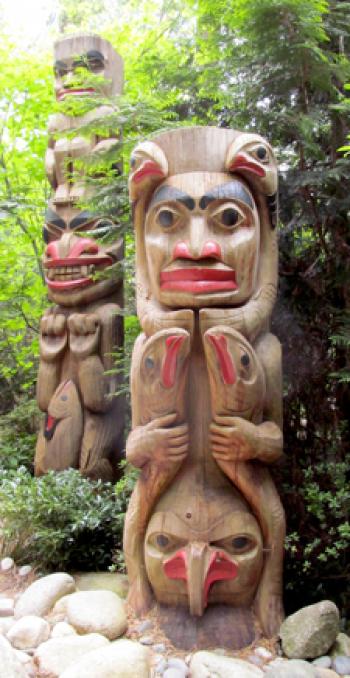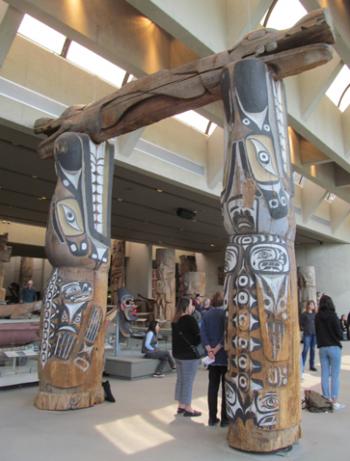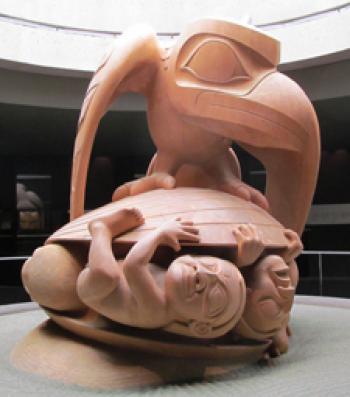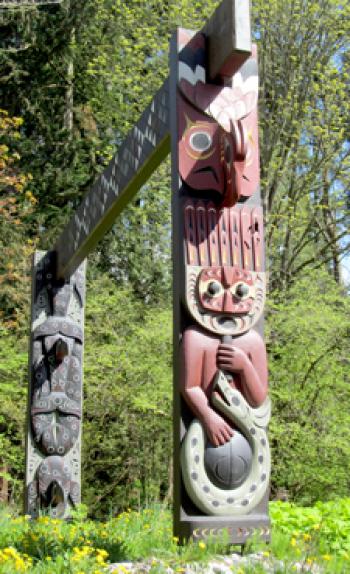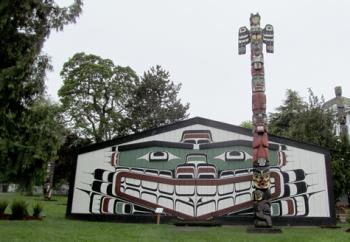Totem poles of the Canadian Northwest Coast
This item appears on page 54 of the November 2017 issue.
Totem poles are the monumental masterpieces of the Pacific Northwest. They are scattered over an area that includes the province of British Columbia in western Canada along with Washington and Oregon states in the northwestern corner of the continental United States plus southeastern Alaska.
Erected by a people who had lived there for thousands of years and whom Canadians call “First Nations,” these totem poles are objects of great beauty — aesthetically pleasing, powerful, even mysterious.
On a month-long trip to British Columbia in May 2017, my husband, Paul, and I visited dozens of totem poles in Vancouver and Victoria in museums and parks, in front of government buildings and even on street corners.
Carved history
Beautiful as I found these totem poles to be, looking at them merely as art objects is to miss the mark. Their beauty is only the first layer.
Totem poles are, as one writer so aptly put it, “carved history.” Carved by Northwest Coast indigenous artisans, totem poles tell stories. It may be the story of a First Nations family’s lineage or of an ancestor’s exploits, actual or legendary.
Totem poles were also used to commemorate special events, such as a conquest, a potlatch (a feast, given on important occasions, in which food and gifts were distributed by the feast giver) or the building of a new longhouse.
Besides totem poles that were freestanding, there were poles placed inside a longhouse or outside it that served a structural purpose while relating a story. Welcome poles were also sometimes erected to greet visitors entering a community.
Mortuary poles, each with a cavity or box at the top to hold ashes, were erected for the deceased.
There were even “shame” poles to castigate those who had committed crimes or who had unpaid debts. These could be taken down once reparation or restitutions had been made.
Totem poles served — and still serve — many purposes.
Earliest totem poles
When the earliest European explorers arrived in the Pacific Northwest, they reported seeing totem poles. However, it was only in the 19th century, with the fur trade and consequent increasing wealth of some First Nations clans, that the carving of totem poles became more common. Totem poles became a status symbol.
In the days before Europeans, bone, stone and shell implements, among other objects, were used to carve totem poles. After European contact, iron tools were utilized, making carving easier and quicker. The wood of choice was often western red cedar, found in abundance in the Pacific Northwest.
Characteristics of carvings
Animal figures are represented most often on totem poles, although human figures appear as well. The animals are either supernatural creatures, like the thunderbird, recognized for its outstretched or folded wings, or real animals. These can each be identified by some distinguishing characteristic: the eagle, with downward-curving beak, a beaver, with large incisor teeth and often with a chewing stick in its paws, or a killer whale, with its long dorsal fin.
Human figures are also readily identified although not necessarily realistically portrayed. There is a particularly fearsome one, with bright- red pursed lips, called Dzunukwa, a female ogress who captures and devours disobedient children. She’s the aboriginal version of the bogeyman (in this case, bogeywoman).
Symbolism of carvings
All these carved figures — animal and human — are part of the story to be “read” on any totem pole. Having a book on Northwest Coast art or an informed guide will help immensely, since each totem pole has its own story to tell and the stories are often complicated.
On a simpler level, each of the carved figures symbolizes some quality; e.g., the thunderbird symbolizes strength and power; the eagle, wisdom; the beaver, industry, and the whale, longevity. Identifying the animal and knowing its particular qualities can add greatly to the enjoyment of viewing totem poles.
Where are the best places to find totem poles in Vancouver and Victoria? There are three great places in each city, but they are by no means the only places where the visitor can find and enjoy totem poles.
Stanley Park
First and foremost in Vancouver is Stanley Park (www.stanleyparkvan.com), a 1,000-acre oasis of green and home to an aquarium, the century-old Brockton Point lighthouse and a fabulous collection of totem poles representing Haida, Kwakwaka’wakw and Nisga’a peoples.
There are also three Coast Salish welcome gateways next to the Stanley Park totem poles, especially appropriate since Stanley Park was once inhabited by Coast Salish people, who had villages and ceremonial sites there. The welcome poles were carved by Susan Point, a Coast Salish artisan, whose work is found all over Vancouver.
The totem poles are located about a mile from the West Georgia Street entrance to the park.
Museum of Anthropology
On a par with Stanley Park, as far as being a “must see,” is the Museum of Anthropology at the University of British Columbia (6393 NW Marine Dr., Vancouver; 604/827-5932, www.moa.ubc.ca), housing one of Canada’s foremost collections of ethnographic artifacts, including Northwest Coast First Nations objects.
Highlights include totem poles displayed inside, in the museum’s Great Hall, as well as outside, side by side with wooden Haida houses, all set beside a pond with a view of the nearby mountains.
The museum is about a half-hour drive by car or taxi, or longer by bus, from downtown Vancouver.
Capilano Suspension Bridge
Most people go to Capilano in North Vancouver (3735 Capilano Rd., North Vancouver; 604/985-7474, www.capbridge.com) to walk the 450-foot-long Capilano Suspension Bridge across a deep gorge. I went for the colorful totem poles and the Kia’palano (where the name Capilano comes from) big house, where carvers are often at work.
The totem poles in this large collection were carved mostly by Coast Salish First Nations craftspeople.
Capilano is about a 15-minute taxi or car ride from downtown Vancouver. In season, there is a free shuttle bus from many points in Vancouver; check the website.
Thunderbird Park
In Victoria, capital of British Columbia, just 30 minutes by seaplane from Vancouver (just one of the ways to reach the city from Vancouver but certainly one of the best), we stayed at the iconic Fairmont Empress Hotel.
Besides its fame for English-style afternoon teatime, the Empress is across the street from Thunderbird Park (phone 250/356-7226, www.royalbcmuseum.bc.ca). This small park, at the corner of Douglas and Belleville streets and adjacent to the Royal British Columbia Museum, is filled with Gitksan, Haida and Kwakwaka’wakw totem poles and features a Wawadit’la big house.
Royal British Columbia Museum
The huge Royal British Columbia Museum (675 Belleville St., Victoria; 250/356-7226, www.royalbcmuseum.bc.ca) houses so much — from fossils to archaeological items that are 10,000 years old. It’s also home to the superb First Peoples Gallery, displaying totem poles, ceremonial masks and a Kwakwaka’wakw big house that you can walk into.
Just as you enter the museum, there are ancient totem poles also exhibited behind glass, some badly deteriorated but now preserved.
Butchart Gardens
People do not usually go to The Butchart Gardens (800 Benvenuto Ave., Brentwood Bay, BC; 250/652-5256 or, toll-free, 866/652-4422, www.butchartgardens.com) to see totem poles. It’s the incredible array of flowers and plants that attracts visitors. But tucked among the flowers are several totem poles.
Butchart Gardens is located 13 miles north of Victoria and can be reached in 30 minutes by car or taxi or in 45 minutes by bus.
If you go…
Those are among the best places to find totem poles in Vancouver and Victoria. There are many other places, as well, where totem poles often stand alone, without totem pole companions. It’s a delight to come upon one of these “stand alones” unexpectedly next to a building or at a street corner.
The Museum of Anthropology in Vancouver has an excellent gift shop, including a bookshop with a first-rate collection about the Northwest Coast First Nations.

